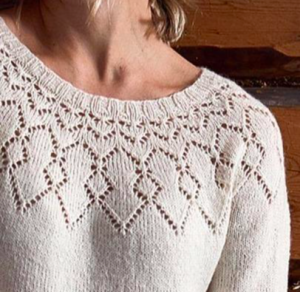Yoke is the upper part of a blouse or top. Many needlewomen fell in love with it, even though it is quite difficult to knit. It can be of various shapes, but the most popular is the round yoke. It is very important for her to make the correct calculations. Otherwise, it will not lie beautifully on the shoulders and will go in waves.
Yoke knitting options:
- From below and around. In this case, knitting begins from the bottom of the finished product, the front, back, and sleeves are knitted. The yoke is knitted on the remaining loops after this.
- All parts of the product are knitted separately. After this, their loops are connected on knitting needles and knitting of the yoke begins.
- From the top. Knitting the entire product begins with the yoke itself.
How to correctly take measurements for a yoke
To knit a yoke you need to take 3 measurements:
- Neck length. If the finished product has a high neck, then it must have a fastener.
- Shoulder circumference.You need to take this measurement by stepping back down from the first 11-13 cm.
- The largest body girth is in the armhole area. To take measurements, you need to raise your arms and measure the volume over the shoulders at the level of the armholes.

How to calculate the number of loops for a yoke
Ready-made patterns most often describe how to knit a yoke correctly, but there are times when you want to knit something yourself.
Before starting calculations, you must make a test sample of 10*10 cm in order to correctly calculate the number of loops.
As a rule, the shoulder circumference is twice as large as the neckline. For example, the neck length is 60 cm, respectively, the shoulder circumference will be 120 cm. The last measurement will be 1.3 times larger than the second, that is, in this case it will be equal to 156 cm. Based on the figures obtained, calculate the required number of loops for each of measurements
After calculating the loops, you need to understand how many increases need to be made. To do this, you need to subtract the total number of loops for the smaller measure from the number of loops of the larger measure. The resulting figure is divided by the desired number of rows.
Openwork yoke with knitting needles

Necessary materials:
- Yarn (420 m / 100 g);
- Circular knitting needles No. 3;
- The yoke is suitable for the finished product size 42-44.
Progress
Cast on 128 stitches on the needles and close them into a ring. Next, knit 2 cm with an elastic band, alternating 2 LP and 2 PI.
After knitting 5 rows with an elastic band, decrease 2 loops.
After this, continue knitting the pattern according to the pattern, repeating the repeat consisting of 5 loops 21 times. You need to repeat the pattern from rows 2 to 6.
Tip: for greater convenience, the knitting needles can be replaced with longer ones when the number of loops on them increases.
- 7 rub. – 168 loops.
- 8–14 p.m. – knit according to the pattern.
- 15 rub. – 210 loops.
- 16–26 r. - according to the scheme.
- 27 rub. – 252 loops.
- 28 – 38 r. - according to the scheme.
- 39 rub. – 294 loops.
- 40 – 50 rub. - according to the scheme.
- 51 rub. – 336 loops.
- 52 rub. - according to the scheme.

Next, knit all the loops until the length of the yoke is 16.5 cm.
At the end, divide all the loops into 4 parts: 98 loops for the back, 70 loops for each sleeve and 98 for the front.
Yoke with a "Wave" pattern
The yoke is designed for a size 44 jumper.
Necessary materials:
- Yarn 100 m/50 g;
- Knitting needles No. 4 and 3.5.
Progress
The yoke is knitted from the bottom up. Cast on 324 stitches on the needles and close them in a circle. Next, continue knitting according to pattern A3, repeat the rapport, consisting of 18 loops, 18 times. Knit another 37 rows according to this pattern and continue working according to pattern A4. After all the patterns, there should be 126 stitches left on the knitting needles. Knit a row of LP, decreasing 30 loops in it.
The height of the yoke is approximately 19 cm.
Then change the knitting needles to number 3.5 and knit 3 cm, alternating 2 LP and 2IP. After this, close off the remaining loops.


 0
0





